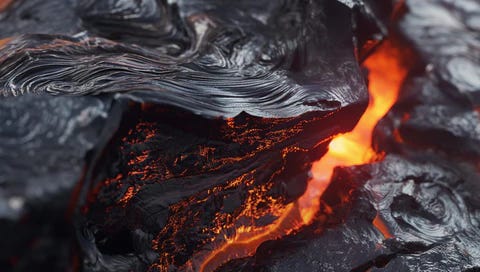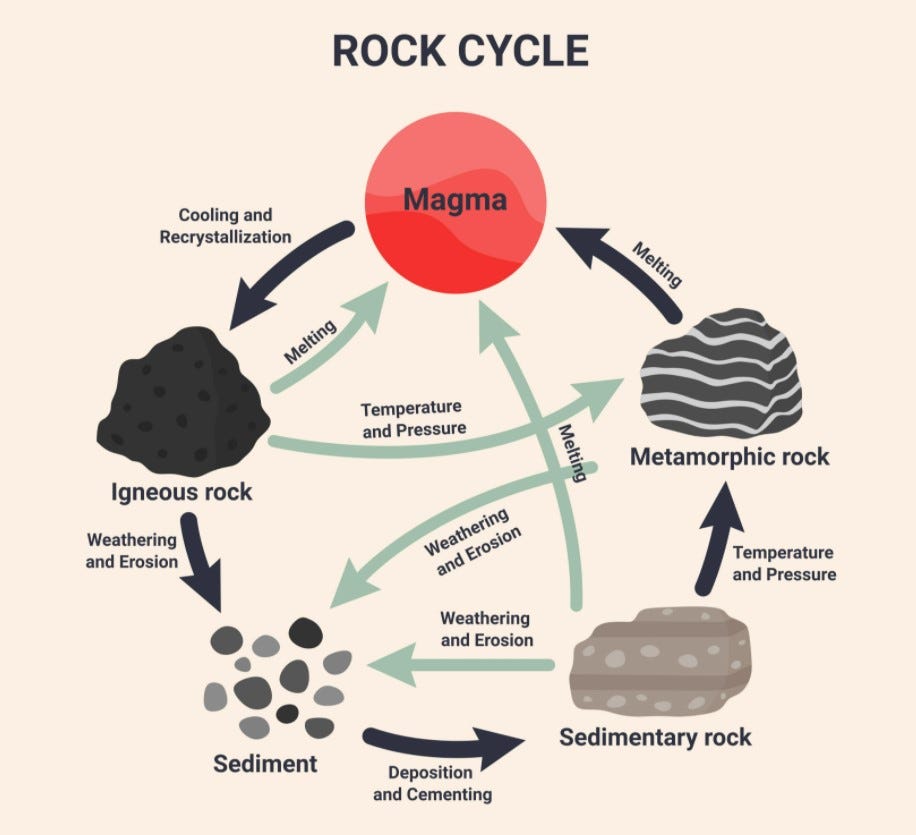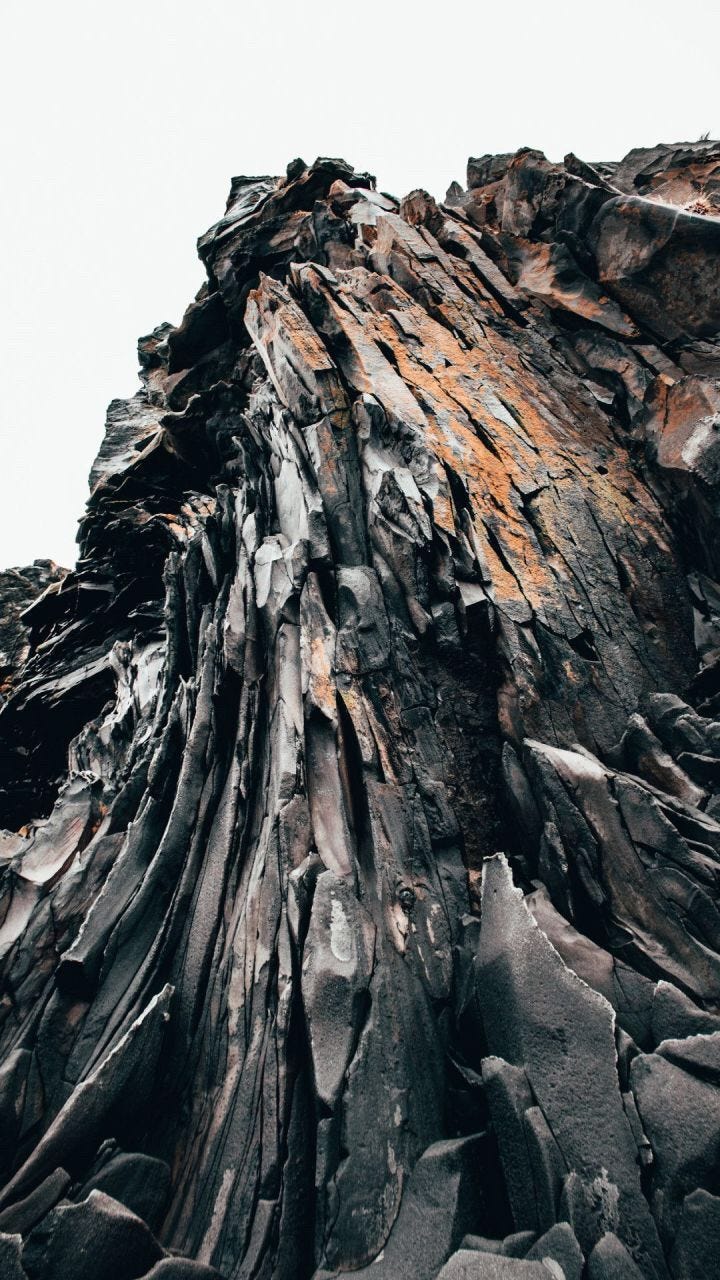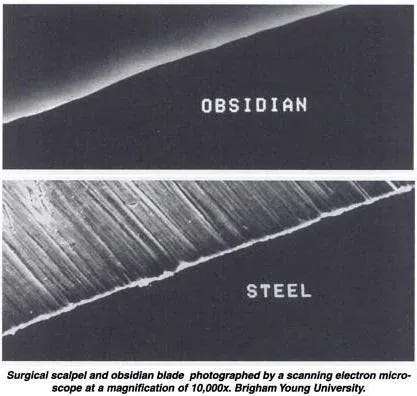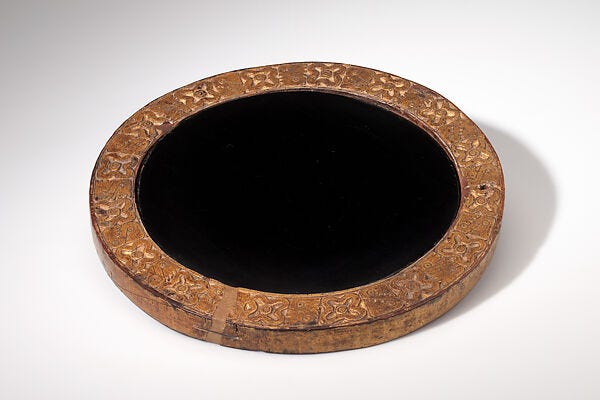Obsidian is a volcanic glass forged when molten rock erupts from a volcano and flows into the ocean, cooling quickly into a glassy substance with no mineral crystals. Earth born when Fire meets Water. Where passion meets depth. It is that moment of supreme tension between opposing forces, resulting is a smooth, dark, stone with sharp edges and a distinctive glossy sheen. Obsidian teaches us that sometimes the biggest transformations come not from gradual evolution, rather moments of spontaneous intensity where all matter emerges greatly changed.
Holding a multifaceted history, obsidian is more than mere stone — It is both a blade and a mirror, the warrior’s dagger and the seer’s looking glass, a tool of survival and of divination, used to pierce both flesh and illusion.
We may view obsidian as nature’s archive of violence transformed into beauty; a testament to the way destruction leads to creation.
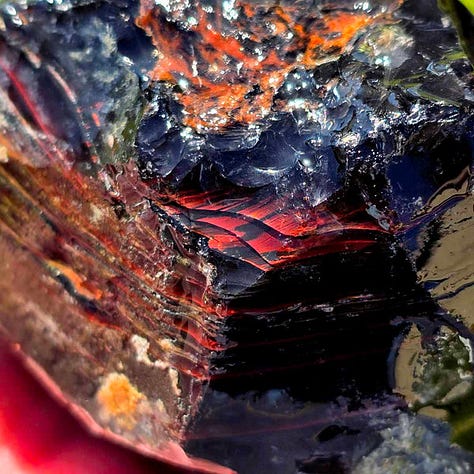

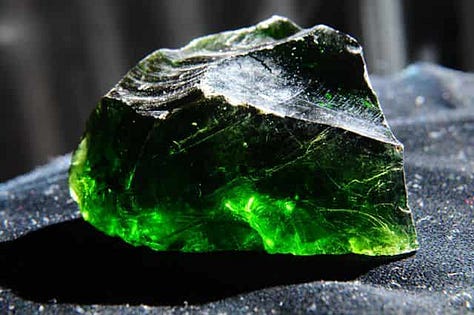
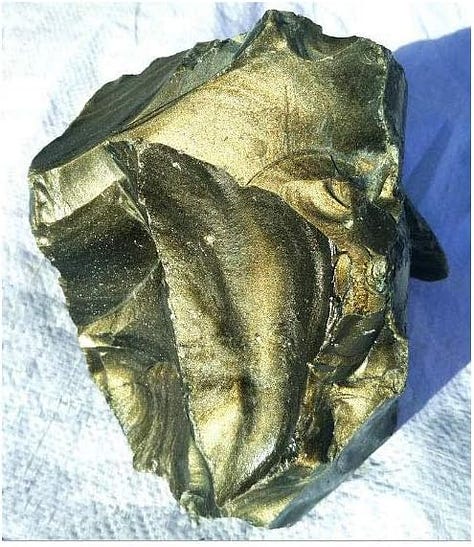
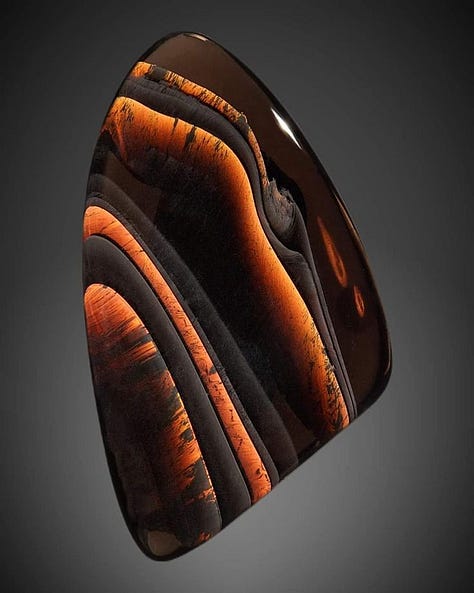
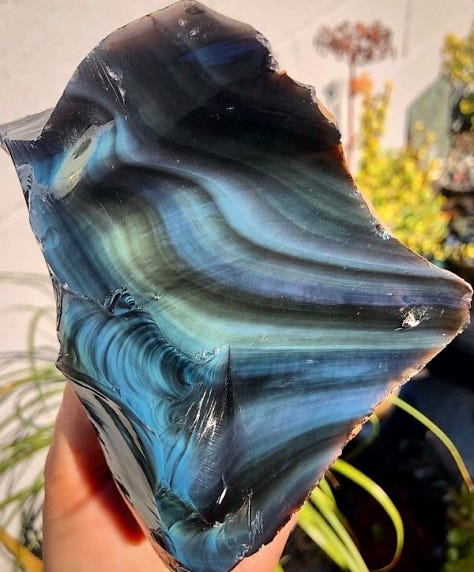
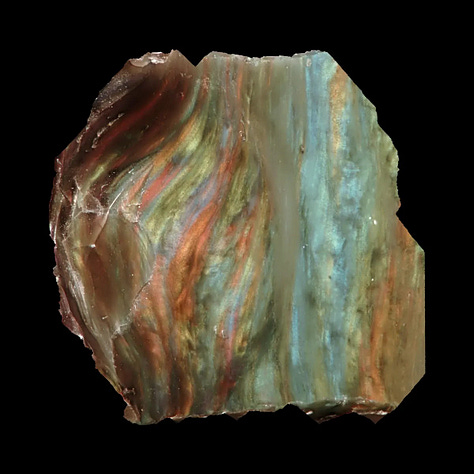
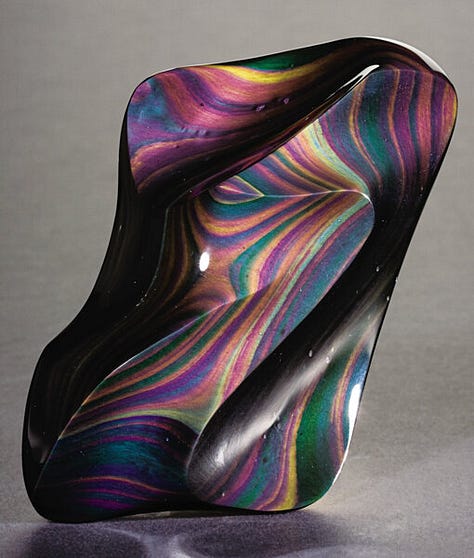
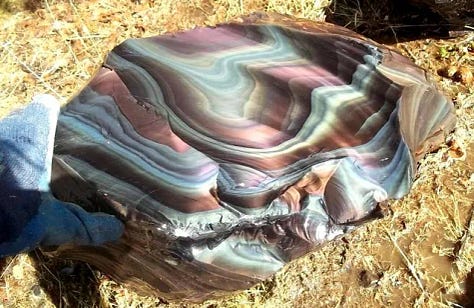
Pure obsidian is typically dark in color, black or deep brown, due to iron and magnesium content. However it can include expressive and colorful variations — snowflake patterns, mahogany swirls, midnight blue, forest green, and rainbow iridescence. Each variety tells its own story of the particular conditions present during its formation: the minerals in the original magma, the speed of cooling, the presence of water and/or bubbles of air.
Obsidian made for attractive jewelry, inlays, and ornaments in many cultures. Prehistoric craftsmen in the East shaped it into decorative bracelets, beads, and vessels as early as the 7th millennia BCE. Obsidian’s relative scarcity, found only near volcanic areas, meant that high-quality obsidian had to be traded over long distances. An unusual shiny black stone from a far-off volcano was seen as exotic and precious, associated with status and prestige.
Take a moment to properly admire her many shades. Breathe her in.
The rock cycle is an alchemical elemental dance of fire, water, pressure, and time. It is how Earth reshapes herself. An eternal act of transformation. There are three main categories of rocks: igneous, sedimentary, and metamorphic. Most of the time they are simple to tell apart. Yet, all connected. They move from one form to another changing shape, texture, and chemical composition along the way.
In geological terms obsidian is an igneous rock whose name comes from the Latin word ignis, or fire. Igneous rocks are born from the cooling of lava or magma. They compose much of the Earth's continental crust and nearly all of the oceanic crust. Other examples of igneous rocks include pumice, basalt, diorite, diabase, granite, and gabbro. The difference between each rock lies in the speed at which they cooled — over seconds or a few million years. Obsidian cools extremely quickly. So quickly, in fact, that crystal growth is prevented from forming. This cooling rate contrasts with other volcanic rocks, which cool slowly forming small grain sizes. Obsidian’s amorphous structure gives it a glass-like quality and ability to break with a conchoidal fracture, a fracture that does not follow any natural planes of separation, creating edges 500x sharper than surgical steel.
Blade Of Truth
Samples of obsidian have been found with cutting edges that are a single atom-thick, the sharpest naturally occurring edge in the world. This stone can get so sharp it will slice individual cells clean in half.
We established that obsidian breaks in a predictable, controlled way when struck properly. This reliability made it a favorite material for weapon-making in cultures that mastered stone knapping. Early humans quickly learned that obsidian could be chipped into arrowheads, spear points, and knives. A skilled artisan could produce dozens of razor-edged flakes from a single core of obsidian — craft specialists could produce long, standardized blades with minimal waste. These were used for as everything from household knives to lancets, for circumcision and cutting umbilical cords, to medical operations, hunting, skinning, and butchering.
The presence of obsidian weaponry is evidenced in art and archaeology; obsidian fragments litter ancient battle sites, and Aztec tribute records list large quantities of obsidian blades provided to the capital.
Sharpness aside, obsidian is quite delicate. It is a fragile stone and can easily be chipped or broken on impact. It does not dull like metal, nor bend like wood, it simply shatters. Capable of the most precise cuts in the world, yet fragile enough to splinter beneath a careless hand. A single blow can turn it to shards. There is something beautiful about this paradox — how its strength is conditional, dependent on softness and care. Obsidian teaches that true power is not about being unbreakable. It is about knowing when to yield.

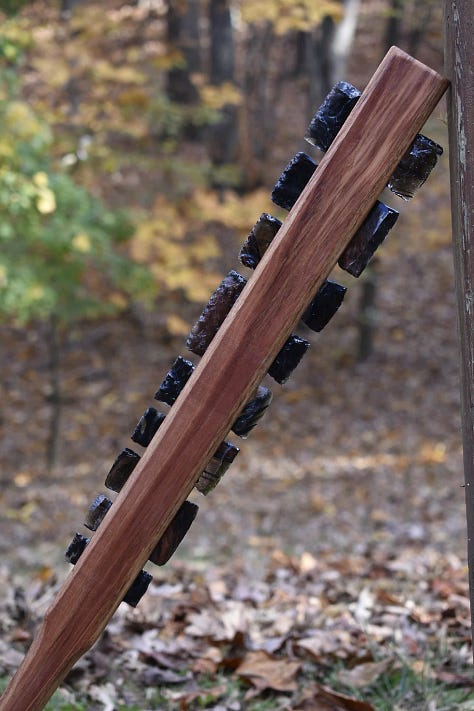
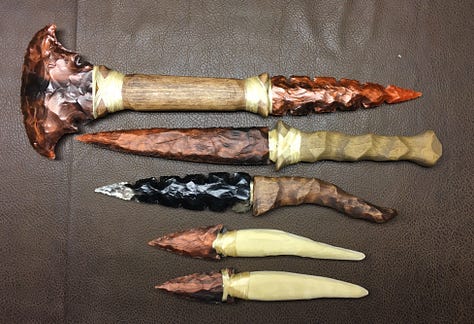
Today, obsidian scalpels are used in medical procedures where very precise cutting is required and where laser surgery is not available. Most notably in delicate cardiac and eye surgery. Its remarkable sharpness allows for precise incisions, resulting in minimal tissue trauma, faster healing, and reduced scarring.
“The biggest advantage with obsidian is that it is the sharpest edge there is, it causes very little trauma to tissue, it heals faster, and more importantly, it heals with less scarring.”
- Dr. Lee Green, University of Alberta
Beyond its physical applications, obsidian holds prominent spiritual and metaphysical significance. In Mayan culture, the day sign "Tijax" is symbolized by the obsidian blade. Tijax represents the double-edged knife used to cut through dense low-vibration energies, serving as a tool for healing and protection. Tijax is about cutting through the façade to expose the underlying truth, making it a symbol of uncompromising honesty and revelation. The energy of Tijax is associated with healers and is believed to have the power to reveal what is hidden in the shadows, facilitating personal transformation and the restoration of balance.
Obsidian's unique combination of physical sharpness and metaphysical depth underscores its reputation as natures’s “Blade of Truth." Its ability to cut through physical matter with precision parallels its symbolic role in piercing illusions to reveal deeper truths within the human psyche. Whether employed in surgical procedures or spiritual practices, obsidian serves as a powerful tool for transformation and healing.
Mirror Stone
Unlike common rocks, a slab of obsidian can be ground and polished to produce a brilliant glossy surface that can be used as a mirror. This property fascinated many people from all over the world. Archaeologists have found evidence of convex obsidian mirrors dating back to sites in Anatolia (Turkey) from as early as 6000 BCE. In Central America, polished obsidian mirrors appear by around 2000 BCE. These early mirrors were luxury items — difficult to craft and highly valued. In contrast to clear quartz or brightly colored gems, obsidian’s opaque blackness suggested the unknown or the underworld. The dark, mystifying, and smoky reflection from obsidian made it an object of scrying.
scry /skrī/ [verb]
foretell the future using a reflective object or surface.
"a mirror used for scrying"
The Aztecs understood polished obsidian served as a window to the spiritual realm, a glittering mirror that mediated between the worlds of gods and men.
Tezcatlipoca, one of the principal Aztec gods, means “Smoking Mirror.” He was the deity of night, sorcery, and ancestral memory. His spirt animal was the Jaguar. In Aztec lore Tezcatlipoca carried an obsidian mirror through which he could observe all that ever happened in the world. Spanish chronicler Diego Durán described an idol of Tezcatlipoca in the Great Temple of Tenochtitlan as being fashioned from polished obsidian with a shining mirror, and said the god “was supposed to observe everything that happened in the world through his mirror”.
For Aztec shamans and healers gazing into a black mirror, often using smoking plumes of incense to aid trance, was a means to commune with Tezcatlipoca’s power — to receive visions of the future or distant events. There are accounts that these mirrors were used to diagnose spiritual ailments, make prophecies, or spy on enemies via mystical insight.
In our digital age we are surrounded by artificial reflections. Screens that show us what we want to see, filters that smooth our edges. This constant exposure to polished illusions can distance us from our authentic selves. The obsidian mirror with its dark, unembellished surface offers a stark contrast. It reflects a raw and unfiltered truth, encouraging introspection and self-awareness. The stone's dark reflective nature symbolically reveals the parts of ourselves we often keep concealed. Perhaps we need obsidian's dark mirror more than ever before: to see ourselves how we are, stripped of performance. Questioning not ‘how do I wish to be seen?’ but rather ‘how deeply am I willing to look?’
Conclusions
Today we view obsidian through a lens that combines ancient wisdom with modern metaphysical concepts. New Age healers understand its energy is said to act like a psychic vacuum cleaner — drawing out negative patterns and buried emotions. Blockades are dissolved, lost knowledge is again accessible, and what was previously unclear and confusing can be seen through.
A stone that armed warriors and surgeons; adorned nobles and statues; used to see into the future and the depths of the soul. Now in modern medicine procedures — lifting veils from clouded eyes, granting clarity where there was once only darkness. Used in ceremony to render what is obscure, clear. Few other rocks have such a dual history of utilitarian and mystical significance.
Quite the romantic history for this living molten memory.
